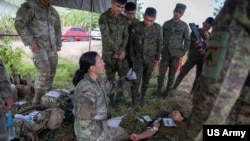For the first time since the Cold War, Beijing officials have condemned the deployment of intermediate-range missiles by the United States in the Asia-Pacific region.
Chinese Foreign Ministry spokesman Lin Jian said at a regular press conference on Thursday that China was “seriously concerned about this” and “strongly opposed to the United States… strengthening its forward deployment at China’s doorstep to seek unilateral military advantage.”
The U.S. military confirmed on Monday that it deployed a medium-range missile system in northern Luzon, Philippines, on April 11 as part of the “Salaknib 24” joint military exercise. This is the first time since the Cold War that the United States has deployed such a system in Asia.
Semi-military-funded Stars and Stripes identified the system as the Army’s latest Typhon launcher, a land-based system that can launch a variety of missiles, including the SM-6 supersonic missile with a range of about 450 kilometers and the Tomahawk cruise missile missile, with a maximum range of 2,500 kilometers.
This means that the system can cover not only the entire Taiwan Strait and the Philippine Luzon Strait, but also the most important cities on China’s eastern coast and China’s military bases in and around the South China Sea.
Stars and Stripes described the system as being “temporarily deployed” for the exercise. Janes, an open source defense and intelligence company, quoted a Philippine Army spokesperson as saying that the missile system will only be used during the Salaknib 24 exercise that ended on April 19 and the upcoming Balikatan 24 exercise. Starts on April 22nd and ends on May 10th.
Still, analysts say the missile deployment is noteworthy.
“Deploying these land-based missiles to the Pacific is a major advance,” said Eric Heginbotham, principal research scientist at MIT’s Center for International Studies. “For example, in the invasion of Taiwan, the Chinese amphibious fleet actually It has to be anchored in a landing zone in Taiwan. Its location is known. These maritime attack Tomahawks can go to work, target the fleet and sink parts of the island,” he told VOA.
Beijing views self-governing and democratic Taiwan as a renegade province that must one day be reunited with the mainland, by force if necessary.
Wilson Beaver, defense budget policy adviser at the Heritage Foundation, told VOA that the U.S. currently deploys only one battery, which likely won’t change China’s military planning unless it becomes more permanent.
“…In the long term, China’s military planning could be seriously complicated if greater numbers of the new systems were deployed into theater, forcing Chinese planners to consider U.S. air, sea, and land bases capable of destroying ships seeking to destroy them. missiles. Ideally, that would be enough to thwart China’s attempts,” he noted.
The U.S. military last year announced plans to deploy a missile defense system in the Pacific this year, but its destination has sparked speculation.
Charles Flynn, commander of U.S. Army Pacific Command, told South Korean media including Yonhap News Agency earlier this month that the missiles would be deployed soon, but he did not disclose the specific time or location.
China has been warning about the plan.
Chinese Defense Ministry spokesman Wu Qian last week called this a “dangerous move that will seriously threaten regional national security and undermine regional peace and stability.”
China’s navy has grown rapidly over the past decade to become the world’s largest navy.
The U.S. Department of Defense estimated in its October report “Military and Security Developments Involving the People’s Republic of China” that China has more than 370 ships and submarines, while the United States has fewer than 300. Increase fleet to 435 aircraft by 2030.
China’s large number of ships and modern navy have raised concerns that it could gain the upper hand in the event of a conflict with Taiwan or a territorial dispute in southern China. Beijing claims sovereignty over much of the sea, putting it on a collision course with Brunei, Indonesia, Malaysia, the Philippines, Taiwan and Vietnam.With the development of China’s navy Maritime experts say U.S. fleet is on ‘downward trajectory’.
Analysts say the deployment of U.S. medium-range missiles in the Philippines will make it more difficult for China to gain regional advantage.
Heginbotham said the missiles would offset China’s advantage of having more warships, “which is why the United States has been buying missiles recently.”
“If you have enough missiles to attack, it almost doesn’t matter how big your fleet is,” he said.
Analysts say China not only has the world’s largest naval fleet, but also the world’s most diverse land-based missile force, giving it powerful anti-access and area denial capabilities.
Raymond Kuo, the first director of the RAND Corporation’s Taiwan Policy Program and a senior political scientist at the RAND Corporation, told VOA: “China has never participated in the intermediate-range nuclear force agreement. Therefore, it has a large “The United States and Russia are part of that deal, so they haven’t developed those missiles as much, and I think having these missiles in the Indo-Pacific helps balance the missiles in the region. It can act as a deterrent,” he said. explain.
Under the constraints of the Intermediate-Range Nuclear Forces Treaty, the United States agreed not to develop and deploy land-based ballistic missiles and cruise missiles with a range of 500 to 5,500 kilometers. Typhon is considered the latest outcome of the withdrawal from the treaty and could make up for the U.S. military’s firepower gap in this range.
While the U.S. Navy and Air Force can also launch sea-launched Tomahawks, and the Air Force can launch air-launched cruise missiles, Guo said this deployment “gives the Army more of a mission in the region and helps actually offset, for example, the Air Force and Some of the challenges facing the Navy.”
Follow us on Google news ,Twitter , and Join Whatsapp Group of thelocalreport.in
